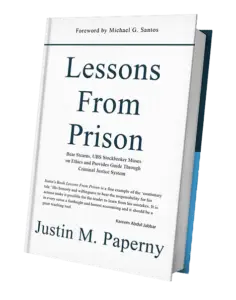When I got sentenced to 18 months in a minimum-security federal prison camp, people said I didn’t deserve a second chance. I had embarrassed my family. I’d created victims. My actions sent my mom to therapy. I understood why people felt that way.
Now, years later, I still hear those same comments—but they’re about other people. Someone will leave a message asking, “Why would you give advice to someone like Elizabeth Holmes? Why are you helping George Santos? They haven’t earned it.”
It’s a fair question. Most people assume someone has to deserve help before they get it. But no one walks into a sentencing hearing already redeemed. You start earning credibility the moment you stop making excuses and say, without conditions: “This is my fault.”
The Sentence That Changed Everything
When I got to prison, I met someone who had been down longer than I had. He didn’t give me a pep talk. He didn’t tell me to feel better. He said: “Stop blaming everyone else. Say it’s your fault. Say it out loud.”
So I did.
I said, “This is my fault. I did it. I hurt people. I damaged my reputation. I cost people money. I embarrassed my family.”
That’s when things started to move in the right direction—not because anyone forgave me, but because I stopped trying to justify what I did. I admitted the truth without trying to soften it, and that gave me a place to begin proving I could do better.
This is the same step George Santos hasn’t taken publicly. And until he does, no judge, no probation officer, no case manager is going to take anything he says seriously.
Saying It Isn’t Enough—You Have to Document It
After I took responsibility, I still had to prove it. I started writing every day. I built a release plan. I created a written record that showed how I was using my time in prison to prepare for the rest of my life.
If I had waited until I got out to start that work, no one would have believed I was serious. And I wouldn’t have had anything to show the court or the BOP.
This is the part most defendants skip. They’ll say they’re sorry, but they don’t write it down. They don’t build a reentry plan. They don’t document progress. They don’t create a single asset that proves they’re trying to repair the harm.
Michael Santos understood this years before I did. He wrote and donated the Release Plan Workbook to thousands of people in federal prison. That workbook didn’t just help people prepare—it helped establish the standard that is now reflected in BOP policy. It laid out exactly how to build a credible record of change, step by step.
And today, there’s no excuse for skipping that step. You can publish your release plan on PrisonProfessorsTalent.com. You can document your growth in a way that probation officers, case managers, and judges can see—and verify.
What Judges Are Actually Looking For
Too many people walk into sentencing believing the judge has already made up their mind. They rely on their lawyer to give a polished speech, send in a stack of character letters, and ask for leniency—without offering any evidence of their own effort or accountability.
But here’s what judges and probation officers are actually looking for:
- Are you taking responsibility without excuses?
- Are you creating a documented plan for the next phase of your life?
- Are you showing, through consistent effort, that you understand the damage you caused?
You can’t answer those questions with a statement at sentencing. You answer them through what you write, what you build, and what you submit in the weeks and months leading up to that day.
If all you bring to sentencing is an apology and some letters from friends and family, don’t expect it to carry much weight. Judges and probation officers see that every day. What they don’t see often is documented, consistent effort that proves you’ve done the work.
When I look back at what helped me earn trust again, it wasn’t the sentence I served—it was the sentence I spoke and followed every day: “It’s all my fault. Hold me accountable. Here’s what I will do moving forward.”
Have you said that yet? And if so, where can someone read the proof?
If you’re ready to build the assets that judges and probation officers actually respect, join our next webinar on Wednesday at 11am Pacific / 2pm Eastern, or schedule a personal call. Start now—while there’s still time to show judges, probation, and the BOP that you’re doing more than waiting.
Justin Paperny



